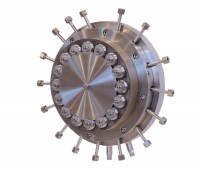04/09/2014
Baker Perkins
Baker Perkins
Creative technology for extruded snacks
At interpack Baker Perkins presented the versatility of the SBX twin-screw extruder and the wide array of extruded snacks that can be achieved for the snack industry.
At interpack Baker Perkins presented the versatility of the SBX twin-screw extruder and the wide array of extruded snacks that can be achieved for the snack industry.
On display was a Baker Perkins SBX Master, a well proven twin-screw extruder used extensively in the snack industry. This plays a key part in the modular Snack Master concept, which enables companies to enter the market with an uncomplicated extrusion system making standard, direct expanded snacks such as corn curls, chipsticks and maize rings. As business expands, a line may be extended in stages to broaden the range of products that can be made to include both traditional and the new generation of indulgent or healthy snacks. These can include
a full portfolio of high specification, complex products including whole grain/multigrain and sweet or savoury filled pillows with intriguing shapes, textures and surface patterns; plus high added-value sticks, pillows, bars and bites in plain, shredded or filled forms.
A standard line usually consists of an extruder, dryer and flavouring system. Special dies and cutters, co-extrusion equipment, dryers, fryers,
ovens and coolers can be added to form versatile plants. New products can be introduced quickly, and short-life products become a profitable option. Extrusion lines can be extended with a Baker Perkins CoEx Master system for production of a wide variety of co-extruded snacks. These systems incorporate fillings with contrasting tastes and textures into a cereal tube which is then formed into individual pillows, tubes, bars or wafers to create high added-value products.
A pillow-crimper, part of the co-extrusion system, was also on show at interpack. This unit cuts the product stream to length and seals it after the die. It provides co-extruded pillow snacks in attractive new patterns such as chevrons, waves and trapeziums. ‘Standard’ shapes such as squares can also be produced, with outline definition much improved compared to previous generation equipment. It is even possible to produce different shapes and flavours simultaneously for variety packs.
The range of dies on show at interpack produced snacks ranging from the standard to the exotic. Plate dies are used to produce a range of direct expanded products such as corn curls, corn balls, multi-grain crisps, maize sticks, wheat/oat pillows, potato maize chip sticks, maize shapes, and coated balls. Die inserts used with plate dies provide a rapid change capability for up to 50 products from a single die, normally for product development. They can be used for production purposes when an especially wide range is made.
Another die serves a unique extrusion process developed by Baker Perkins to make a completely new range of products. This die produces a thin, wide sheet of dough that is cut into regular, geometric shapes by an in-line rotary cutter. The shapes may be fried as a conventional snack, or oven baked for a lower fat content, and then flavoured. Some types of crackers and biscuits can also be produced.
A new colour change system allows changeover between variations of an extruded snack to be made ‘on the run’: for example, matching the colour of vegetable-flavoured snacks such as carrot, beetroot, tomato, broccoli or peas in a single pack. Colour is injected in the die, and the transition phase is extremely rapid. This skid-based system spells an end to the inconvenience and cost of cumbersome mixing and storage of different
coloured snacks, with its impact on waste, hygiene and shelf life.

